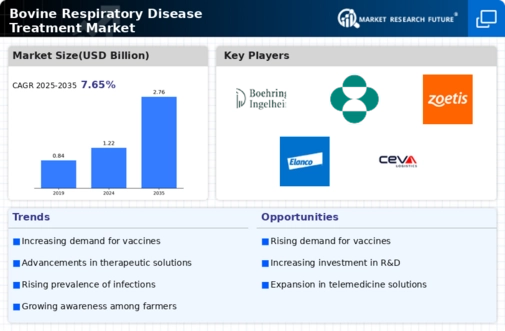Growing Awareness of Animal Health
There is a notable increase in awareness regarding animal health and welfare among livestock producers, which significantly influences the Global Bovine Respiratory Disease Treatment Market Industry. Producers are increasingly recognizing the economic implications of BRD, leading to a greater emphasis on preventive measures and timely treatment. Educational initiatives and outreach programs have been instrumental in promoting best practices in herd management. This heightened awareness is likely to contribute to a compound annual growth rate of 7.69% from 2025 to 2035, as stakeholders prioritize investments in health management strategies.
Advancements in Veterinary Medicine
Technological advancements in veterinary medicine play a crucial role in shaping the Global Bovine Respiratory Disease Treatment Market Industry. Innovations such as improved diagnostic tools and novel therapeutic agents enhance the ability to detect and treat BRD effectively. For instance, the development of vaccines and antimicrobial treatments has shown promise in reducing disease prevalence. As these advancements continue to evolve, they are expected to drive market growth, with projections indicating a market size of 2.76 USD Billion by 2035, underscoring the importance of ongoing research and development in this field.
Market Trends and Growth Projections
The Global Bovine Respiratory Disease Treatment Market Industry is characterized by dynamic trends and growth projections. The market is anticipated to experience a robust expansion, with a projected value of 1.22 USD Billion in 2024 and an increase to 2.76 USD Billion by 2035. The compound annual growth rate of 7.69% from 2025 to 2035 reflects the ongoing commitment to improving animal health and addressing the challenges posed by BRD. This upward trajectory indicates a promising future for stakeholders involved in the development and distribution of bovine respiratory disease treatments.
Economic Impact of Livestock Production
The economic significance of livestock production serves as a driving force for the Global Bovine Respiratory Disease Treatment Market Industry. Livestock farming is a vital component of the agricultural economy, and BRD poses a substantial threat to productivity and profitability. The financial burden associated with disease management and treatment can be considerable, prompting producers to seek effective solutions. As the market evolves, the focus on enhancing livestock health and minimizing economic losses is expected to drive demand for innovative treatment options, thereby fostering growth in the industry.
Regulatory Support for Animal Health Products
Regulatory frameworks supporting the development and approval of animal health products are pivotal for the Global Bovine Respiratory Disease Treatment Market Industry. Governments and regulatory bodies are increasingly facilitating the introduction of new treatments and vaccines, ensuring that they meet safety and efficacy standards. This supportive environment encourages innovation and investment in the sector. As a result, the market is expected to expand significantly, with an anticipated growth trajectory that aligns with the rising demand for effective BRD treatments, ultimately benefiting livestock health and productivity.
Increasing Incidence of Bovine Respiratory Disease
The rising prevalence of Bovine Respiratory Disease (BRD) among cattle is a primary driver for the Global Bovine Respiratory Disease Treatment Market Industry. Factors such as intensive farming practices and environmental stressors contribute to the increased incidence of this disease. Reports indicate that BRD accounts for a substantial percentage of mortality in feedlot cattle, leading to significant economic losses for producers. As the demand for effective treatment options grows, the market is projected to reach 1.22 USD Billion in 2024, reflecting the urgent need for innovative therapeutic solutions.

















Leave a Comment